了解別人的人聰明,了解自己的人明智。 [Chinese] - Those who understand others are clever, those who understand themselves are wise.
Knowing that you do not know is the best. Not knowing that you do not know is an illness. - Tao Te Ching chapter 71
Introduction
Taoism, a profound Chinese philosophy and religion, has shaped Chinese culture for over two millennia. Rooted in the concept of the Tao (“the Way”), it offers a path to harmony with the universe through simplicity, spontaneity, and alignment with nature. From its origins in the chaotic Warring States period to its modern global presence, Taoism has evolved from a philosophical guide to a multifaceted religion, blending mysticism, ritual, and folklore. This article explores its early beginnings, its transformation over centuries, and its contemporary expressions, highlighting key differences between its philosophical and religious forms.
Early Beginnings: The Warring States and Philosophical Roots
Taoism emerged during China’s Warring States period (475–221 BCE), a time of relentless conflict and social upheaval following the decline of the Zhou dynasty (1046–256 BCE). As feudal states vied for power, the common people bore the brunt of war and instability, fostering disillusionment with traditional authority. This era birthed the “Hundred Schools of Thought,” a flowering of philosophies addressing governance, ethics, and human purpose. Among these, Taoism and Confucianism rose to prominence, offering contrasting visions of order.
Taoism’s foundational figure, Laozi (Lao-tzu, meaning “Old Master”), is traditionally credited with authoring the Tao Te Ching, a concise yet enigmatic text of roughly 5,000 characters. Likely composed in the 4th or 3rd century BCE, its authorship is debated—some scholars suggest it’s a compilation rather than the work of one person. Laozi, possibly a court archivist named Li Erh, is shrouded in myth; legends claim he was born with white hair after a prolonged gestation, symbolizing wisdom. The Tao Te Ching outlines the Tao as the ineffable, universal principle governing existence, advocating wu-wei (non-action), humility, and alignment with nature’s flow over societal ambition.
Another key figure, Zhuangzi (Chuang-Tzu, 369–286 BCE), expanded Taoism’s philosophical depth through his eponymous text, the Zhuangzi. His parables, like the famous butterfly dream, explore relativism and the fluidity of identity, blending humor with profound insights. Zhuangzi introduced concepts like yin-yang (from the I Ching), emphasizing balance and interconnectedness. Early Taoism was mystical yet practical, urging individuals to shed ego and societal constructs to live in harmony with the Tao. Unlike Confucianism’s focus on social roles and duty, Taoism championed individual freedom and retreat from worldly strife.
Evolution into Religion: Han Dynasty and Beyond
By the Han dynasty (206 BCE–220 CE), Taoism began shifting from philosophy to organized religion. This transformation was driven by popular demand for immortality and supernatural powers, spurred by texts like the Tao Te Ching’s hints at longevity. Alchemists sought elixirs of immortality, often using toxic substances like mercury and lead, mistakenly believing they mimicked nature’s balance of yin and yang. Emperor Wu of Han, while officially endorsing Confucianism, was fascinated by Taoist immortality practices, funding alchemical experiments and rituals.
In the 2nd century CE, Zhang Daoling (Chang Tao-ling) founded the Celestial Masters sect, marking Taoism’s formal religious turn. Based in western China, this group practiced magical healing, alchemy, and rituals, charging members five pecks of rice—hence the name “Five Pecks of Rice Taoism.” Zhang claimed a divine revelation from Laozi, establishing himself as the first Celestial Master. His sect organized communities, blending Taoist philosophy with folk beliefs, and later sects continued this trend, deifying Laozi and incorporating gods like the Eight Immortals.
During the Tang dynasty (618–907 CE), Taoism flourished as a state-supported religion, rivaling Buddhism. Temples, monasteries, and nunneries were built, mirroring Buddhist structures. Taoism absorbed elements of Chinese folklore, Buddhism, and ancestor worship, creating a pantheon of deities like the City Gods and Door Guardians. Rituals for protection, exorcism, and festivals became central, with priests offering services for hire. This religious Taoism diverged sharply from its philosophical roots, embracing magic, talismans, and elaborate ceremonies.
Modern Taoism: Philosophy, Religion, and Global Reach
Today, Taoism exists in two primary forms: philosophical and religious. Philosophical Taoism, rooted in the Tao Te Ching and Zhuangzi, emphasizes personal reflection, meditation, and living simply. It appeals to intellectuals and spiritual seekers worldwide, particularly in the West, where translations of Taoist texts have inspired mindfulness practices and environmentalism. Concepts like wu-wei resonate with modern ideals of balance and non-striving, influencing fields from psychology to martial arts.
Religious Taoism, practiced primarily in China, Taiwan, and Chinese diaspora communities, centers on temples, rituals, and festivals. Organizations like the China Taoist Association, founded in 1957, oversee thousands of temples and priests, integrating Taoist practices with state oversight. Globally, an estimated 12–50 million people engage with Taoist practices, though exact numbers are hard to pin down due to syncretism with Buddhism and folk religion. In Taiwan, Taoism blends with local traditions, while in the West, it often manifests as hybrid spiritual practices, like Taoist-inspired yoga or qigong.
Key modern practices include:
- Meditation and Qigong: Breathing and energy exercises to cultivate health and spiritual alignment.
- Rituals: Offerings at temples, festivals like the Ghost Festival, and protective talismans.
- Environmentalism: Taoist principles of harmony with nature inspire eco-conscious movements.
Differences Between Early and Modern Taoism
- Philosophy vs. Religion: Early Taoism was a mystical philosophy focused on individual liberation and natural harmony. Modern Taoism splits into philosophical study (emphasizing texts) and religious practice (rituals, deities, and temples).
- Scope and Syncretism: Early Taoism was a response to social chaos, rejecting rigid structures. Modern Taoism incorporates Buddhist, Confucian, and folk elements, with a structured priesthood and pantheon absent in early texts.
- Goals: Early Taoists sought alignment with the Tao through simplicity. Later, religious Taoism pursued immortality and supernatural powers, while modern practitioners often focus on health, mindfulness, or cultural heritage.
- Global Reach: Early Taoism was confined to China. Today, it’s a global phenomenon, with philosophical Taoism influencing Western spirituality and religious Taoism thriving in Chinese communities.
Conclusion
Taoism’s journey from a Warring States philosophy to a global spiritual tradition reflects its adaptability. Born in turmoil, it offered a radical vision of harmony through non-action, articulated by Laozi and Zhuangzi. Over centuries, it absorbed religious elements, becoming a vibrant faith with rituals and deities. Today, Taoism bridges ancient wisdom and modern needs, inspiring both introspective seekers and temple worshippers. Its enduring message—living in flow with the universe—remains as relevant as ever.









